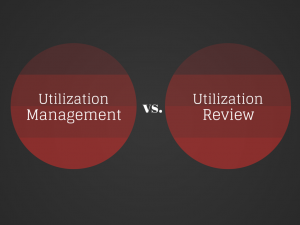| Editor's Note: Our network compliments your organization’s push for integration optimizing UR and UM benefits with a national network of practicing clinicians. Click here about how this approach and expertise sets BHM review services apart. Learn more about utilization review today. |
 Understanding the difference between Utilization Review and Utilization Management is very critical in the healthcare continuum. While the two terms often feel interchangeable, in reality their processes and meanings actually are very different. Their differences make all the difference for improving care.
Understanding the difference between Utilization Review and Utilization Management is very critical in the healthcare continuum. While the two terms often feel interchangeable, in reality their processes and meanings actually are very different. Their differences make all the difference for improving care.
Utilization Review
Utilization review focuses on health care providers reviewing patient records in order assessing if complete and accurate treatment/services occurred. UR safeguards “against unnecessary and inappropriate medical care.”
Utilization review also uses physician documentation and other medical records to determine a patient’s discharge disposition.
Independent Review Organizations (IROs) are typically brought into utilization review instances to help ensure objective and unbiased reviews are completed.
Utilization Review Is Designed to...
- Validate the necessity of medical services/treatment requested
- Validate if the duration of healthcare services/treatment requested occurred within the right time frame
- Validate quality and level of services/treatment provided were appropriate given the circumstances for our Medical Necessity Criteria White Paper)
Utilization Management
Utilization Management is process of responding to the utilization review results. Through Utilization Management, plans and procedures are developed for improving the outcome of reviews.
Utilization management processes often include...
- Concurrent planning
- Discharge planning
- Pre-certification
- Clinical case appeals
While utilization review identifies and addresses service metrics that lie outside the defined scope, while utilization management ensures healthcare systems continuously improve and deliver appropriate levels of care. Reducing the risk of cases that need review for inappropriate or unnecessary care.
- Facilities and staff resources are being utilized effectively
- There is ongoing education and monitoring to ensure advanced levels of patient care
- Decisions are made on data-based information
- Medical costs are managed
- There is improved communication between payers, providers, and insurers
The Role of the IRO
IROs are a very important liaison between providers and the payers. They abide by strict federal and local standards when they review services for medical necessity and appropriateness.
IROs help provide a clear view along many different parts of the healthcare continuum, and have a certain level of expertise that allows them to make solid, unclouded judgements. Partnering with an IRO can help cut down on internal administrative costs and expedite day-to-day activities. IROs increase accuracy and make solid unbiased judgments which can help lower the risk of fraud and reduce liability.
